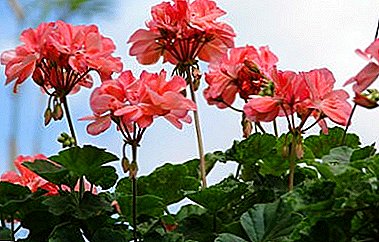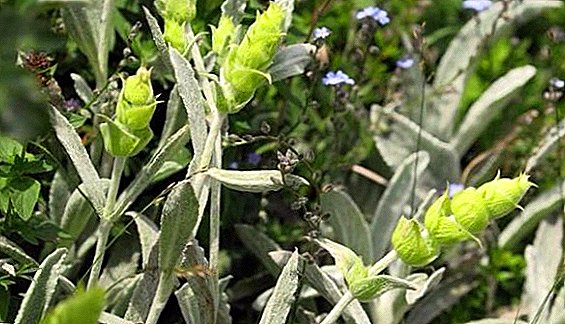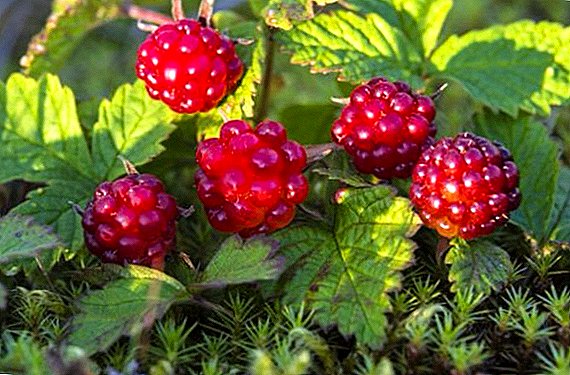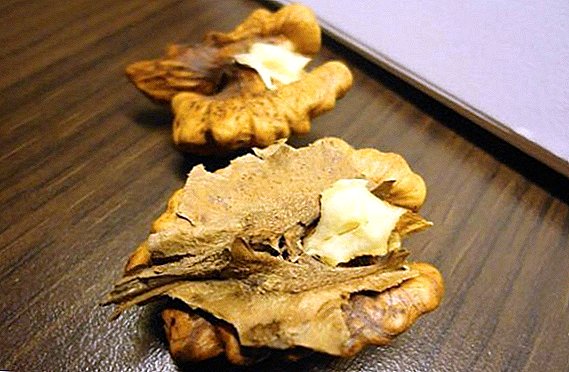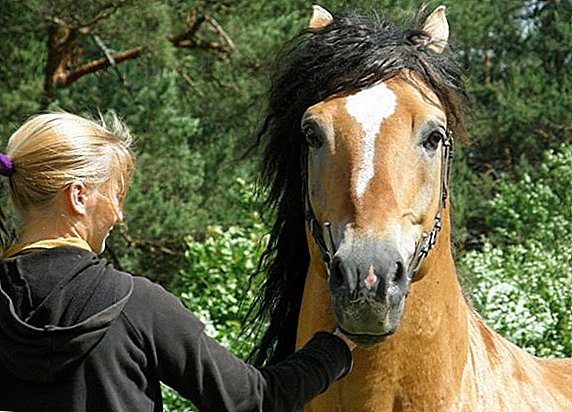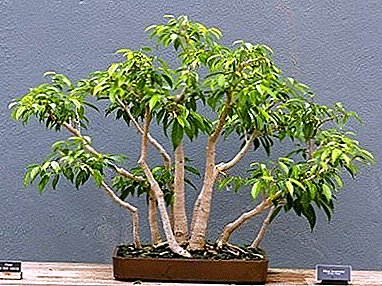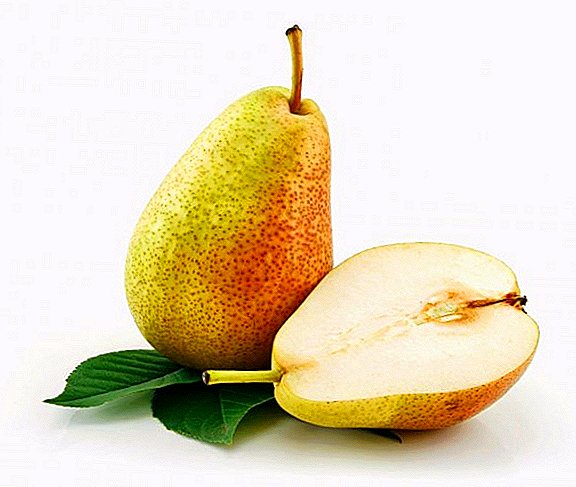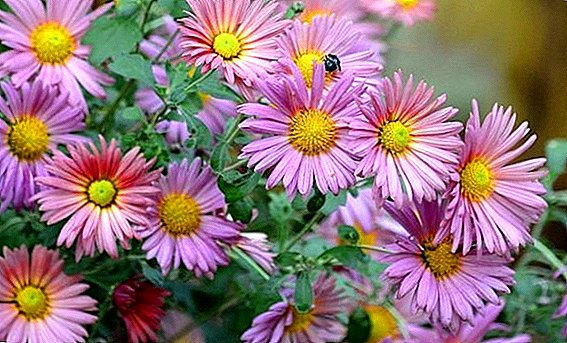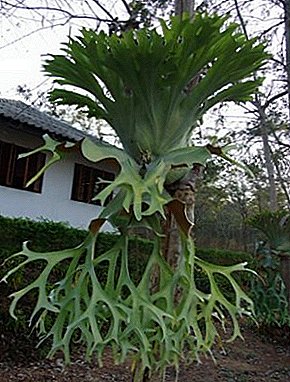
Platicerium belongs to the Millipede family along with Polypodium. This is the most unusual fern, which is not similar to any of its "relatives": it grows on trees and has two types of leaves.
The first, sterile, tightly pressed to a tree or the ground. They serve as both a support and peculiar pockets where water is accumulated, foliage of other plants and insects.
All this eventually decays and becomes nutrition for the roots of platicerium. Another type of leaves - sporiferous, perform the functions of reproduction and photosynthesis.
They are flat, long and patterned - resemble deer antlers, for which the plant received the same name.
Fern "Deer Horns" is found in the Asian and Australian rainforests, on the islands of the Indian Ocean. And on the outside, and on the home window sill, the platicerium can grow to very large sizes. The main thing - the right care.
Kinds
Two-stork
Sporiferous leaves of this species reach a length of about 50-70 cm They have a gray shade and are going to the outlet. In young plants the leaves are covered with thick white down. At the base they are wedge-shaped, the upper part expands, forks into several lingual lobes hanging down.
Sterile leaves are round and most often whole, less often - with notches around the edges, they are pressed to the ground. As they grow older, the plants turn brown and dry.

Hill
This look is similar to two-stemmed, but it is distinguished by many compact, straight leaves with a shallow dissection. Some segments look shorter and sharper.
Photo subspecies Platicerium Hill:
Big
Its sterile leaves have a pale green color and do not dry out for a long time. They are raised, deeply dissected and have the shape of a fan. Their width can reach 1.4 meters. Sporiferous leaves are also evenly dissected from the middle, and the belt-like lobes hang down.

Angolan
Sporiferous leaves of this species expand upward, but do not have a cut. Their lower part is triangular-wedge-shaped, covered with down of orange hue. The upper part of the sterile leaves is folded back.
Photos of the Angolan subspecies:
Elkorogiy
Its sporiferous leaves, reaching 30 cm in length, Do not hang down, but stand upright. They only sag from lack of light. Also, this type of plant requires more water than its "brothers".

Home care
Features care after purchase
Since in nature platicerium grows in trees, at home it is grown on pieces of bark. To do this, the roots of the plant should be wrapped in a wet mixture of sphagnum moss and some coarse-grained peat, and then tied to the bark or any other suitable decorative support.
Also ferns are placed in hanging pots. If there is no support in the form of bark, add rotting from deciduous trees to the soil. A quarter of the tank should occupy the drainage layer at the very bottom.
Lighting
The Platicerium loves light, but it is still better to take care of it from the direct rays of the spring and summer sun. Choose a moderately shaded spot for the fern, for example, a western window. In winter, it can be moved to the south, but do not forget to protect it from direct sun.
Temperature
"Deer Horns" love warmly. In summer, the plant is comfortable at 18-25 degrees of heat, in winter it is acceptable to lower the temperature to at least 15 degrees. Platicerium does not like drafts, take care of the fern from them.
Air humidity
Platicerium prefers high humidity. However, it is absolutely impossible to wipe the leaves - there is a risk of damaging the tiny velvety hairs on the surface that trap moisture from the air.
 Therefore, it is sufficient to periodically spray the "horns" from the smallest sprayer so that water does not remain on the leaves as drops.
Therefore, it is sufficient to periodically spray the "horns" from the smallest sprayer so that water does not remain on the leaves as drops.
If there is an open aquarium or other source of humidity in the room, it is useful to place the “Deer Horns” closer to it.
Watering
For fern recommended generous and regular watering twice a week. Drying of the roots is unacceptable. Water for irrigation needs soft, it needs to be defended and bring to room temperature.
Water must be poured into the slots between the ground and sterile leaves. In winter, when the platicerium rest period, watering should be reduced.
Fertilizers (dressing)
Feed the "Deer Horns" complex fertilizer designed specifically for the ornamental foliage plants. A portion for platicerium should be taken in two times smaller than recommended in the instructions.
Fertilize the plant should be from April to September once every two weeks. 2-3 times in the summertime, you can pour fern with nutrient solution from mineral and organic fertilizer.
Transfer
Usually, adult platiceriums do not transplant. Young plants, if necessary, in the spring can be wrapped with new moss and placed in a larger container.
At the same time, remember that tear off dead anchor leaves is impossible.
The soil
The substrate for "Deer Horns" may be of different composition. The soil may contain bark, sphagnum and roots of other ferns. Another option: coarse-fiber peat mixed with moss, leafy ground and unrepaired leaves.
Of the ready-made soil mixtures for branched ferns sold in stores, the soil for orchids is best suited.
Breeding
Disputes
 When the plant reaches the age of 7-9 years, spores are formed on its leaves. When they ripen, they are shaken off on a sheet of paper and March is sown.
When the plant reaches the age of 7-9 years, spores are formed on its leaves. When they ripen, they are shaken off on a sheet of paper and March is sown.
Sowing is done in wet sphagnum, but Before this, in order to sterilize the soil, it is necessary to pour boiling water over it and let it cool.
The sowed container should be covered with glass and left in a warm, shaded place for several days.
Soil to be regularly sprayed with water. Young mature plants can be settled in separate pots and accustomed to the usual watering and lighting.
Dividing bush
In the case of transplantation, the young fern can be carefully divided and transplanted into different containers.
Shoots
The escaped shoots are carefully separated from the adult plant and planted in separate pots filled with about half of the pebbles and wet moss.
The soil should be plentifully watered and covered with foil. for a few days. Once the sprouts take root and become stronger, you can transfer them to the "adult mode".
Diseases and pests
Malicious insects that are dangerous to Platicerium include scale insects (appear due to dry heat), thrips and spider mites. You can get rid of them by spraying (but not rubbing) the leaves of the "deer antlers" with a solution of insect repellent.
Beneficial features
"Deer horns" destroy a certain part of gaseous hydrocarbons and purify the air in the room. Also platicerium prevents the development of pathogenic microorganisms.
Conclusion
Platicerium is the favorite of flower growers who prefer unusual plants. It will add notes of exotic to any interior and will become its catchy decoration.
Other indoor ferns include: Pelley, Pteris, Cirtomium, Asplenium, Adiantum, Davallia, Blehnum, Salvinia, Polypodium, Nephrolepis, Uzzhnik and Grozdnik.


